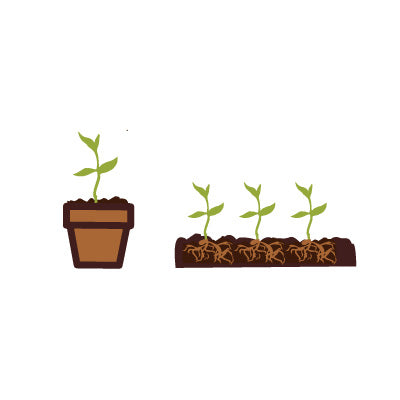Planting a vegetable garden is an age-old tradition that has become more popular than ever. Growing one’s own food is tremendously pleasurable and rewarding. There's nothing better than venturing into your garden for a fresh tomato, cucumber, or pepper that you grew from seed. Like any gardening project, a few basic ground rules will ensure the best results.

WHERE TO PLANT VEGETABLE SEEDS? INDOORS OR OUTDOORS
Unlike some other more finicky types of seeds, vegetable seeds tend to be a versatile lot! They can be successfully planted either indoors or out in the garden. For gardeners with limited space or resources, indoor planting is usually the way to go. Small-space gardening is hugely popular and can result in a surprisingly large harvest. For others with even a small patch of earth, it's easy to sow vegetable seeds directly into the soil. Whatever your preference, the planting process is a lot more cut-and-dry than you may think, and it’s also great fun!

PLANTING VEGETABLE SEEDS INDOORS
The process of sowing vegetable seeds indoors is called “seed starting." To begin, find a shallow pot with holes in the bottom for drainage. Fill the pot with rich potting soil, and water generously. It’s important not to drown the soil, but rather add just enough water to make it moist. Once the soil is properly prepared, simply press your vegetable seeds into place using the instructions found on the seed packet.
Next, as the days pass, watch for germination. The first thing you’re likely to see is a set of small leaves. Continue to water regularly so the soil and seed mixture stay evenly moist as your plants begin to grow. It’s also a good idea to feed your plants a good water-soluble fertilizer every week or so to stimulate growth.
After your seedlings have sprouted, you may wish to transplant them to individual pots to prevent overcrowding and/or prepare them for eventual transplanting outdoors. This is accomplished by simply watering the seedlings just prior to removal and gently lifting them out with a spoon or small trowel. Set the seedlings into their new pots, carefully firming the soil around the roots. As usual, continue to water lightly and fertilize as necessary.
If you choose to transplant your fledgling plants to an outdoor vegetable garden, be sure to wait until any danger of frost has passed. It’s also recommended that you transplant on a mild and overcast day – or even at night - so as not to “shock” the previously pampered house plants. Just prior to transplanting, water the plants to loosen the soil and then simply tap them out of their pots. Remove the plant and soil and place the plant in a previously dug hole, making sure that it's level to the ground.

PLANTING VEGETABLE SEEDS OUTDOORS
Unless you live in an area where summers are really short, you're better off sowing some types of vegetable seeds directly in a garden. Large-seeded, fast-growing vegetables, such as corn, melons, squash, beans, and peas usually languish if they're grown in containers for even a day or two too long.
Before direct sowing, make sure the soil has dried sufficiently and is warm enough for the seeds you want to plant. If your soil temperature is much below 65°F (18°C), the seeds are likely to rot in the ground before they sprout. The best way to determine the temperature of your soil is to use a soil thermometer, which you can purchase at any garden store.
You can plant vegetable seeds in a variety of patterns, though the most common method is row planting. If you have a large area or allotment, you’ll probably find this method the easiest. Even if you’re dealing with just a few square feet, you can still plant in rows.
Mark the placement of a row within your garden, and then make a furrow at the correct depth along the row. Some seeds may not sprout, so sow seeds thicker than you want the final spacing of the crops to be. Thinning rows is less of a chore if you space seeds as evenly as possible. Cover the seeds with fine soil and firm them in with the back of a hoe to make sure that all the seeds are in contact with the soil.
Once your vegetable seeds are sown, make sure to water regularly until they sprout. Soon after seedlings grow their second set of true leaves, you may want to thin them out to avoid overcrowding. When you thin plants, either discard the extra seedlings or move them to another part of your garden. Newly transplanted seedlings need extra attention until they get established.
Voila – you’ve done it! Now it’s time to kick back and watch Mother Nature do her thing.

